Feasibility of Wheat Bran as the Sole Nutrient Source of Platymonas helgolandica var. tsingtaoensis
CHEN Xue-hao, HU Jia-cai, LI Shi-na, ZHOU Li-hong
College of Fisheries, Jimei University, Xiamen 361021, PRC
Abstract The growths of algae under different concentrations and treatments of wheat bran were studied in order to investigate the feasibility of wheat bran as the sole nutrient source of Platymonas helgolandica var. tsingtaoensis. The results showed that adding wheat bran directly to the algal fluid can promote algal growth. The algal growth was inhibited for the first 10 d and accelerated dramatically thereafter. For the comparison between the algae whose growth was modified by using wheat bran packed in a teabag or boulting cloth bag, and that by using loose wheat bran only, results showed that, at the same concentration, the algae grew faster and without lag phase when the wheat bran was packed in a teabag or a boulting cloth bag than when loose wheat bran was used only. In addition, when the wheat bran was packed in a boulting bag, the algal growth was slightly better than when the wheat bran was packed in a teabag. When the concentration of wheat bran ranged from 0.5 to 4 g/L, the cell density rose with the increase of the concentration of the wheat bran, however, the algal growth was inhibited completely at 8 g/L. At a concentration of 4 g/L, the fast-growth phase of the algae with the wheat bran aerobic pretreatment started 6 d earlier than that with wheat bran packed in a teabag, whereas there was no significant difference between them in final cell density. In terms of cell growth, the algal growth at 1 g/L wheat bran was close to that at f/2 medium during the experimental period. The study showed that it is feasible to use wheat bran as the sole nutrient source for the culture of Platymonas helgolandica var. tsingtaoensis.
Key words Wheat bran; Nutrient; Algae; Teabag
1. Introduction
Wheat bran is the hard outer layer of the wheat kernel, which is filled with various nutrients and fiber. It contains non-starch polysaccharides (41%~60%), protein (15%~20%), starch (10%~20%)[1], fat and various mineral elements such as calcium and phosphorus[2-3]. Wheat bran is a source of dietary fiber for humans, and it is also used as livestock feed. It is very palatable to most classes of animals. Wheat bran is a bulky feed that can be used to lighten dense and heavy feed mixtures.However, some researchers claim that wheat bran is not easily digested by animals because it is rich in lignocellulose, hence its usage as animal feed is limited. Besides, the imbalance of nutrients and low protein content in wheat bran also limit its usage[4-6]. Although there are ways to turn wheat bran into highvalue products, the utilization of wheat bran is still inadequate[7]. Finding effective ways to use wheat bran remains a long-term task.
Microalgae, being important primary producers, contain various biologically active substances and nutrients such as proteins, polysaccharides, lipids, minerals, etc., which are easily digested and absorbed by animals, thus microalgae are widely used in the food industry, cosmetics, animal feed, medicineetc.[8-9]. Moreover, microalgae are regarded as potential source of bioenergy[10-11]. Algal cultivation is currently a hot topic of research due to its low cost, easy cultivation, and high productivity[12]. Microalgae such as photoautotrophic algae that use inorganic matter as nutrients, heterotrophic algae that use organic matter in darkness as nutrients[13-15], and mixotrophic algae that use both inorganic and organic matter as nutrients[16-19]have diverse and changeable metabolic patterns. Many microalgae can grow in different metabolic patterns under different conditions[20-21]. Thus, it is possible to cultivate microalgae with some sewerage or agricultural waste to obtain algal products and remove the pollutants. WONG M Het al.[22]used the extracts of tea and soybean meal forChlorella pyrenoidosaculture. COMBRES Cet al.[23]reported that Chlorella and Scenedesmus can utilize organic substances for growth under both light and dark conditions. ZHU J Yet al.[24]found that ferulic acid from rice bran promoted the growth ofEuglena gracilis. Some organic pollutants are also reported to promote algae growth, such as domestic sewage[25-26], crop byproducts[27-28], and food processing wastewater[29-31].
There have been many studies on the culturing of freshwater algae using bacteria or fungi to degrade wheat bran. EL-SHEEKH M Met al.[4]used the water-soluble substance of wheat bran treated with fungi for 7 d as the medium of chlorella and cyanobacteria to obtain an increase of biomass and protein and carbohydrate contents. HE Y Qet al.[25]used the soluble components of fermented wheat bran and two fungal species mixed with domestic wastewater to cultivate some green algae and to purify sewage for irrigation. However, there was no report on the feasibility of wheat bran as a unique nutrient for microalgae growth, and there was little research on algae cultured with wheat bran in seawater. This work aims to study the effects of wheat bran on the growth ofP. helgolandicavar tsingtaoensis, which is widely used in marine aquaculture, especially in the nursery industry. Then the feasibility of using wheat bran as a nutrient source forP. helgolandicavar tsingtaoensis, as well as the effects of various concentrations of wheat germ solutions and application methods on the growth rate ofP. helgolandicavar tsingtaoensis, are evaluated.
2. Materials and Methods
2.1. Experimental materials
Platymonas helgolandicavar. tsingtaoensis was obtained from the Fisheries College of Jimei University. Prior to the experiments, the microalgae was cultivated at 28±1°C in a 12:12-h day/night cycle at a light intensity of 80 μmol/m2·s, in f/2 media[32]prepared with sterile filtered seawater. Cells in the exponential growth phase were used in the experiments.
Wheat bran was obtained from a farm-owned wheat processing plant at Suqian (China) and stored in sealed plastic bags at 4 °C. The teabag for packing the wheat bran, size 67 mm×80 mm, was made of filter paper with many irregular pores (pore size close to 200 mesh sieve). Another kind of packing bag (boulting cloth bag) was made with a 200-mesh sieve and was a similar size to the teabag.
2.2. Experimental design
The aim of this study was to develop a simple and inexpensive way to cultivateP. helgolandicavar. tsingtaoensis using wheat bran. The study was comprised of three steps. The first step was to find the relationship between the algal growth and the concentration of wheat bran. Algae grown in sterilized seawater using f/2 medium were used for controls. The nutrients provided by the seawater and f/2 medium, including total nitrogen (TN), total phosphorus (TP), chemical oxygen demand (COD) and ammonia (NH3-N), were measured according to PRC National Standard methods (GB 17378.4-2007). To measure the release of nutrients from the wheat bran, the concentrations of the nutrients were measured after 2 g/L wheat bran was aerated at room temperature (28±1°C) for 2 and 10 d. The second step was to compare the effects of different methods of applying the wheat bran in the algae culture, such as using loose wheat bran in the solution or packed in a teabag, using different types of packing bags and different numbers of bags. The third step was to cultivate the algae with the aerobically pretreated wheat bran. Finally, the feasibility of using the wheat bran as a nutrient resource and the best method of obtaining the best growth rate was revealed. The parameters of cell density, the specific growth rate, and cell growth productivity were investigated. All tests were conducted in triplicates.
2.2.1. Growth ofP. helgolandicavar. tsingtaoensis in different concentrations of wheat bran
P. helgolandicavar. tsingtaoensis was cultivated in a 250 mL baffled flask with 100 mL working volume. The algal cells were inoculated at the exponential growth phase so that the initial cell density was about 5×104cells/mL. Wheat bran at concentrations of 0.5, 1, 2, 4 and 8 g/L was used as the study sample, and an algal culture without wheat bran was used as the control. Samples were taken every two days, and the cell number was counted using a blood count slide. Lugol solution was used to stop cell movement. The specific growth rate was calculated according to Equation (1).

Where:µrefers to the specific growth rate (divisions/day);NtandN0are the cell density at timetand time 0, respectively.
2.2.2. Comparison of the algal growth in the wheat bran medium and in the f/2 medium
The experimental method was the same as that described above. The concentrations of wheat bran used were 0, 0.5, 1 and 2 g/L, and an algal culture grown in an f/2 medium was used as the control. Cell growth productivity was calculated according to Equation (2).

Where: P refers to cell growth productivity (cells/mL·day);NtandN0are the cell density at timetand time 0, respectively.
2.2.3. Effects of packed and loose wheat bran on the growth ofP. helgolandicavar. Tsingtaoensis
The experimental method was the same as that described above. The concentrations of wheat bran were 1 and 4 g/L. Each concentration of wheat bran was used in two different treatments, one directly added to the algae (i.e. loose), the other packed in teabags (i.e. packed) and then the teabags were dipped in algae. The algae without wheat bran was the control. The rate of increase of cell density was calculated according to Equation (3).

Where: I refers to an increased rate of cell density (%);Nttis the cell density of the treatment at timet;N0tis the cell density of the control at timet.
2.2.4. Effects of the numbers of teabags for the packed wheat bran
P. helgolandicavar. tsingtaoensis was cultivated in a 2 L baffled flask with 1 L working volume. The concentration of wheat bran was 2 g/L. For the experiments with the teabags, the wheat bran was packed either in a teabag, evenly in 4 teabags, or in a boulting cloth bag. 1 L algae containing 1 or 4 empty teabags or 1 empty boulting cloth bag were used as the control. In addition, 2 g/L wheat bran packed in a teabag was put in 1 L sterilized seawater to observe the changes in the water’s appearance and smell.
2.2.5. Effects of pretreated wheat bran on the algal growth
3.6 g of wheat bran was added to 500 mL sterilized seawater and aerated for 10 d at room temperature (28±1°C). It was then filtered with a screen and the volume of filtrate was readjusted to 600 mL with sterilized seawater. Afterwards, it was used as the pretreated aerobic wheat bran solution.P. helgolandicavar. tsingtaoensis was cultivated in a 500 mL baffled flask with 300 mL working volume. The concentration of wheat bran was 4 g/L. Pretreated wheat bran and wheat bran packed in a teabag were used. 300 mL-algae without wheat bran was used as the control.
2.3. Statistical analysis
Results are presented as means ± standard deviation (SD). Data were tested by one-way ANOVA using SPSS software.P-value<0.05 was considered significant.
3. Results and Discussion
3.1. Effects of wheat bran concentrations on the growth of P. helgolandica var. tsingtaoensis
Among all experimental groups, the group of 8 g/L wheat bran had the lowest cell density at all times, even lower than that of the control (P<0.01). Pigments in the group turned yellow after 4 d. Under the microscope, a large number of broken cells were seen in the culture. During the first 6 d, there was no significant difference in cell densities between the 8 and the 4 g/L wheat bran solution (P>0.05), whereas the cell density at 4 g/L was significantly higher than that at 8 g/L after 8 d (P<0.05). For the wheat bran with concentrations ranging from 0.5 to 4 g/L, as the experimental time increased, the time of the occurrence of the highest cell density increased as well. At a concentration of 0.5 g/L, the highest cell density occurred after 4 d. At a concentration of 1 g/L, the highest cell density occurred after 6 d. At a concentration of 2 g/L, the highest cell density occurred after 8 d. At a concentration of 4 g/L, the highest cell density occurred after 14 d. This indicated thatP. helgolandicavar. tsingtaoensis can adapt itself to the environment with wheat bran. The higher the concentration of wheat bran, the longer the adjustment time was, except for 8 g/L wheat bran, which completely inhibited the algae growth. Generally, there was no significant difference in cell density between the concentrations of 0.5 and 1 g/L (P>0.05). The cell density of 4 g/L wheat bran was much lower than that of the lower concentrations during the first 10 d, whereas it increased sharply at the 12thday by 662.02% from the 10thday, then it kept the highest cell density until the end of the experiment (Fig. 1a).
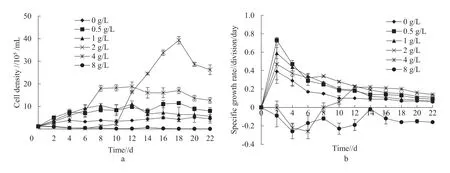
Fig. 1 Effects of the concentrations of wheat bran on the growth of P. helgolandica var. tsingtaoensis (a: the growth curve of P. helgolandica var. tsingtaoensis; b: the specific growth rate of P. helgolandica var. tsingtaoensis)
Table 1 showed that, in any stage, the average cell density of 8 g/L wheat bran was the lowest among the control and treatments. When the concentration was less than or equal to 4 g/L wheat bran, the higher the concentration of wheat bran was, the greater the average cell density was. The relationship between the average cell density and the concentration of wheat bran could be expressed asY=2.582X+5.244,R2=0.874; whereYwas the average cell density during the experiment (0~22 d),Xwas the concentration of wheat bran (g/L); andY=5.830X+4.267,R2=0.960; whereYwas the average cell density at stage L (12~22 d). The L/F ratio of most groups was more than 1, except that of 8 g/L. And the group of 4 g/L wheat bran had the highest L/F ratio (Table 1). It can be seen from a comparison of two slopes that the concentration of wheat bran had a greater influence on the algae growth in the later stage (12~22 d). This is most likely related to the diffusion of nutrition from the wheat bran. When 2 g/L wheat bran was aerated in the water, the 10 day concentration of both total phosphorus and total nitrogen were much higher than the 2 day concentration (Table 2). This meant that with the passage of time, more and more, nutrition of the wheat bran might be dissolved in the water. Thus, the algae would get more nutrition in the later stage than in the earlier stages. Except for the 8 g/L wheat bran, the average cell density of each concentration for the latter half of the experiment was higher than that for the first half. Especially when the concentration was at 4 g/L wheat bran, the average cell density showed the biggest change, with the average cell density in the later stage (12~22 d) being 24.89 times that of the earlier stage (0~10 d) (Table 1).

Table 1 The average cell density of each concentration of wheat bran at different stages ×105/mL
Fig. 1b showed how the concentration of wheat bran affected the growth rate ofP. helgolandicavar. tsingtaoensis. The specific growth rates of the lower concentrations (0.5~2 g/L wheat bran) were significantly higher than those of the higher concentrations (4~8 g/L wheat bran) (P<0.05), during the first 10 d. During the experiment, the specific growth rates of 8 g/L wheat bran were always negative. The negative growth rate occurred in 4 g/L wheat bran at the first 6 d, whereas its growth rate increased sharply to 0.20 at the 12thday, and remained the highest value as the experimental time progressed.
For algae, the increase of cell density represents algal growth and means to get a large quantity of biomass or metabolic products. Generally, a good medium should promote the rapid increase of algal density and it should maintain that high cell density for a long time. In this study, when wheat bran was used to cultivateP. helgolandicavar. tsingtaoensis, the growth-promoting effect was observed only in concentrations from 0.5 g/L to 4g/L wheat bran. The average cell density of each concentration during the experiment was 1.85~3.90 times the control, which indicated that wheat bran contained the substances needed to support the growth ofP. helgolandicavar. tsingtaoensis. Some researchers have reported that some species of bacteria can convert the solid of wheat bran into soluble nutrients. It is considered that the growth of bacteria converted the cellulose and protein of the wheat bran into soluble organics and nitrogen[25,33-34]. In this study, bacterial activity should exist because the wheat bran used in the experiment was unsterilized. Those natural species of bacteria could do the same thing as the artificially added bacteria. Using unsterilized wheat bran to cultivateP. helgolandicavar. tsingtaoensis has two advantages. One is that it is conducive to the degradation of the wheat bran. The other is that it makes it more convenient and economical to cultivate the algae. As shown in Table 2, the concentrations of TN and TP in 2 g/L wheat bran were much higher than those in the f/2 medium. It means that there may be enough nutrients in the wheat bran solution for algal growth. This could be one of the reasons why the algal growth was totally inhibited in 8 g/L wheat bran. The concentration of nutrients beyond the tolerance range of the algae may be harmful.
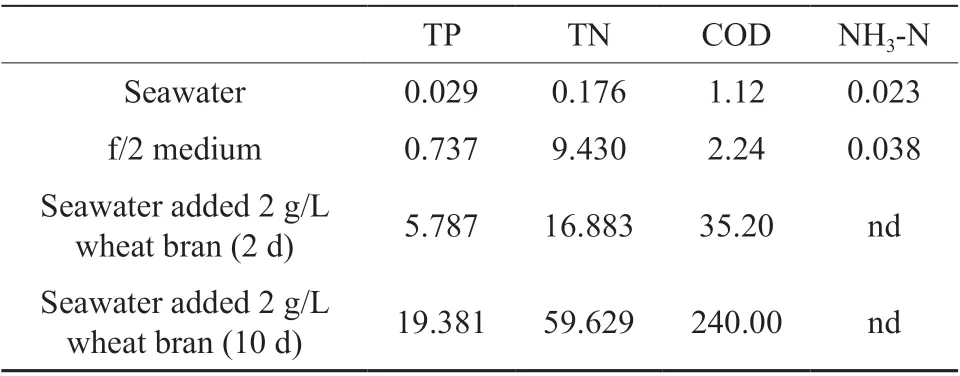
Table 2 Concentrations of nutrients in experimental solutions mg/L
Fig. 2 showed no significant difference in cell growth productivity between 1 g/L wheat bran and the f/2 medium (P>0.05), except at the 4thand 6thday, with a little higher value in the f/2 medium (P<0.05). This indicated that 1 g/L wheat bran was roughly as effective as the f/2 medium in promoting algal growth. The cell growth productivity of 2 g/L wheat bran was significantly lower than that of the other treatments in the first 10 d (P<0.05), close to that of f/2 medium and the 1 g/L wheat bran after 12 d (P>0.05), whereas it was much higher than all the other treatments during the later stage (14~28 d) (P<0.05) at 1.51~3.43 times that of the f/2 medium. This might mean that algae need a longer time to adapt to the higher concentration of nutrition in 2 g/L wheat bran. As for 0.5 g/L wheat bran, the cell growth productivity was less than that of the f/2 medium for most of the time (P<0.05), thereby it did not meet the nutritional needs ofP. helgolandicavar. tsingtaoensis. All the above showed that it was feasible to apply wheat bran directly inP. helgolandicavar. tsingtaoensis culture and the concentration for obtaining the best growth results was 1 g/L wheat bran, which can achieve similar algal growth to that with f/2 medium. The higher concentration (≥2 g/L) was not suitable because the inhibition of growth in the early stage was unfavorable to establish a steady algal culture system unless certain methods can be found to eliminate such inhibition. There are some advantages to using wheat bran as the nutrients ofP. helgolandicavar. tsingtaoensis. First, it is cheaper and much simpler than f/2 medium. Second, it’s ecofriendly to convert an agricultural waste into a more valuable biomass. In addition, the nutrients are slowly released from the wheat bran, just like slow-release fertilizers, which can support the steady growth of algae for a long time.
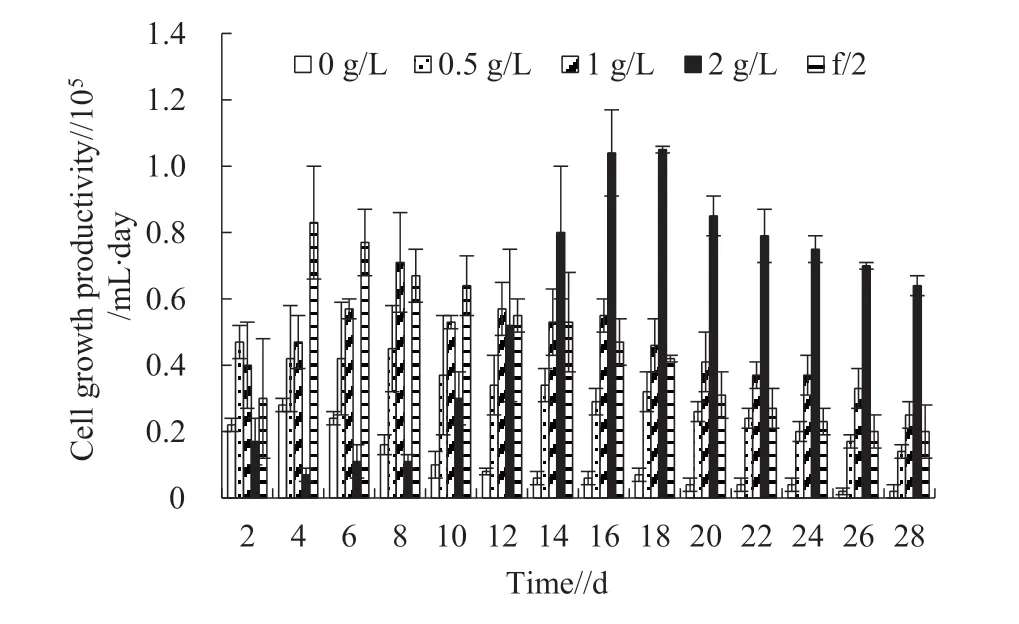
Fig. 2 Cell growth productivities of P. helgolandica var. tsingtaoensis in different concentrations of wheat bran and f/2 medium
3.2. Effects of wheat bran usage on the growth of P. helgolandica var. tsingtaoensis
Light intensity, one of the most important factors for algae, can affect algal photosynthesis and growth. Generally, insufficient light can result in the slow growth of algae. CAI Z Pet al.[35]reported that the growth ofDunaliella salinaandPlatymonas subcordiformisunder shade conditions was slower than under normal light conditions. Wheat bran is tiny. It can make water turbid and thus block the light. Therefore, the shade effect increases with the increase of the concentration of wheat bran, which is unfavorable to algal photosynthesis. Fig. 3 showed that the packed wheat bran promoted the cell density of the algae growth at the same concentration as that of the wheat bran. Compared with the loose wheat bran, the wheat bran packed in a teabag saw a higher increasing rate of algae, and the higher the concentration of wheat bran, the larger was the difference between the two methods. The increase in the rate of cell density with packed wheat bran was significantly higher than that of loose wheat bran at 4 g/L (P<0.01), however, there was no difference between two methods at 1 g/L wheat bran (P>0.05). At a concentration of 4 g/L,P. helgolandicavar. tsingtaoensis with packed wheat bran grew rapidly after 4 d, and reached the plateau 8 d later, while the algae with loose wheat bran did not start growing until the 10thday (Fig. 3). This indicated that the packed wheat bran had a greater influence on the growth ofP. helgolandicavar. tsingtaoensis. At a high concentration of wheat bran, the growthpromoting effect of the packed wheat bran was much greater than that of the loose wheat bran. The teabag used in the experiment can block the particles of wheat bran and only let the water-soluble substance to be released to the culture, hence it reduced the shade effect. Obviously, it is beneficial to the algal photosynthesis. Wheat bran was used directly (loose), the shade effect at the lower concentration (1 g/L) was not as strong as that at the higher concentration (4 g/L), thus, there was no significant difference in the growth rate between the two methods at the lower concentration. At the same concentration, the cell density of the two was close over time because the amount of nutrients was related to the concentration of wheat bran and had nothing to do with how the wheat bran was packed. KIM Jet al.[36]and LI C Fet al.[37]reported that light intensity only affected the growth rate of algae and did not affect the biomass in its stationary phase.
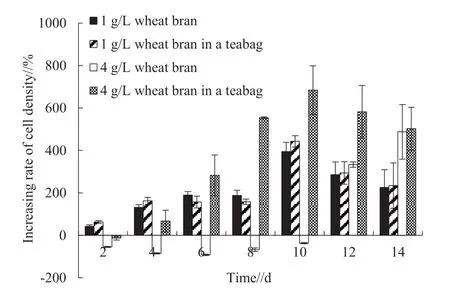
Fig. 3 The rate of cell density of P. helgolandica var. tsingtaoensis in two methods of using wheat bran
There was no significant difference between the cell density of the control and all the treatments with empty bags (P>0.05), whereas the cell densities with packed wheat bran were higher than that of the control (P<0.05) (Fig. 4). This indicated that the beneficial effect forP. helgolandicavar. tsingtaoensis was from the wheat bran rather than from the bag. At a concentration of 2 g/L wheat bran, there was no significant difference between the cell densities of the two treatments when the wheat bran was packed in one or four teabags (P>0.05). Compared with the use of the tea bag for packing, wheat bran packed in a boulting cloth bag had significantly higher cell density after 8 d (P<0.01), whereas no significant difference was observed in the earlier stage of the experiment (the first 8 d). The boulting cloth bag and the tea bag were made of different materials, which may have caused a difference in the release and absorption of soluble nutrients from the wheat bran. Considering the packaging effect and durability, a 200-mesh boulting cloth bag was more suitable for packing wheat bran inP. helgolandicavar. tsingtaoensis culture.
The 2 g/L wheat bran tea bag in sterilized seawater became turbid after 1 d and smelt rotten after 3 d. However, the water of the treatment group with bothP. helgolandicavar. tsingtaoensis and wheat bran packed in a tea bag was always clear and green without a bad smell. In general, the decomposition of organic matter by microorganisms can mainly be divided into aerobic and anaerobic decomposition depending on the amount of oxygen and microbial species. Aerobic degradation is a fast and thorough process in which macromolecular organic matter can be degraded into CO2, H2O, as well as other inorganic substances (such as nitrogen and phosphorus compounds) which are easily utilized by algae. Anaerobic decomposition, being usually slow and incomplete, will produce NH3, H2S, organic acids, and some intermediate products, which will emit a bad smell. In water which contains both wheat bran and algae, the oxygen produced by the algae helps the wheat bran break down aerobically, meanwhile, those degraded substances can be absorbed by the algae, hence the degradation process can continue. On the contrary, the water which contains only bran but no algae might lack enough oxygen for aerobic bacteria, thus the organic matter degrades anaerobically, and produces an unpleasant odor. Therefore, the coexistence of algae and microorganisms in the culture may be a possible mechanism for the growth ofP. helgolandicavar. tsingtaoensis using wheat bran. In this study, it is convenient and inexpensive to cultivate algae using wheat bran without disinfection, compared with using the degraded substances from the wheat bran by artificially adding specific microorganisms.
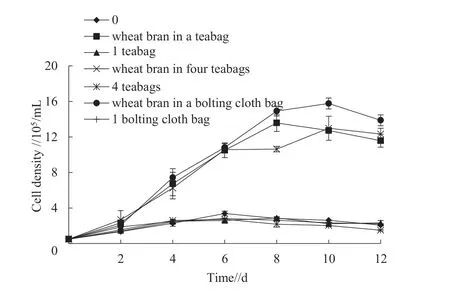
Fig. 4 The growth curve of P. helgolandica var. tsingtaoensis with 2 g/L wheat bran packed in different bags
3.3. Effects of aerobic pretreated wheat bran on the growth of P. helgolandica var. tsingtaoensis
At a concentration of 4 g/L wheat bran, both the cell density and the specific growth rate for the treatment with pretreated wheat bran added aerobically were significantly higher than that of teabag treatment for the first 6 d (P<0.01). Then there was no difference between the two groups from the 8thday to the end of the experiment. Compared with the control without wheat bran, the cell density and specific growth rate of the aerobically pretreated wheat bran were always higher during the experiment (P<0.01). As for the treatment with wheat bran packed in a teabag, the two parameters were higher than those of the control after 6 d (P<0.05), whereas no significant differences were observed before that (P>0.05)(Fig. 5a, 5b).
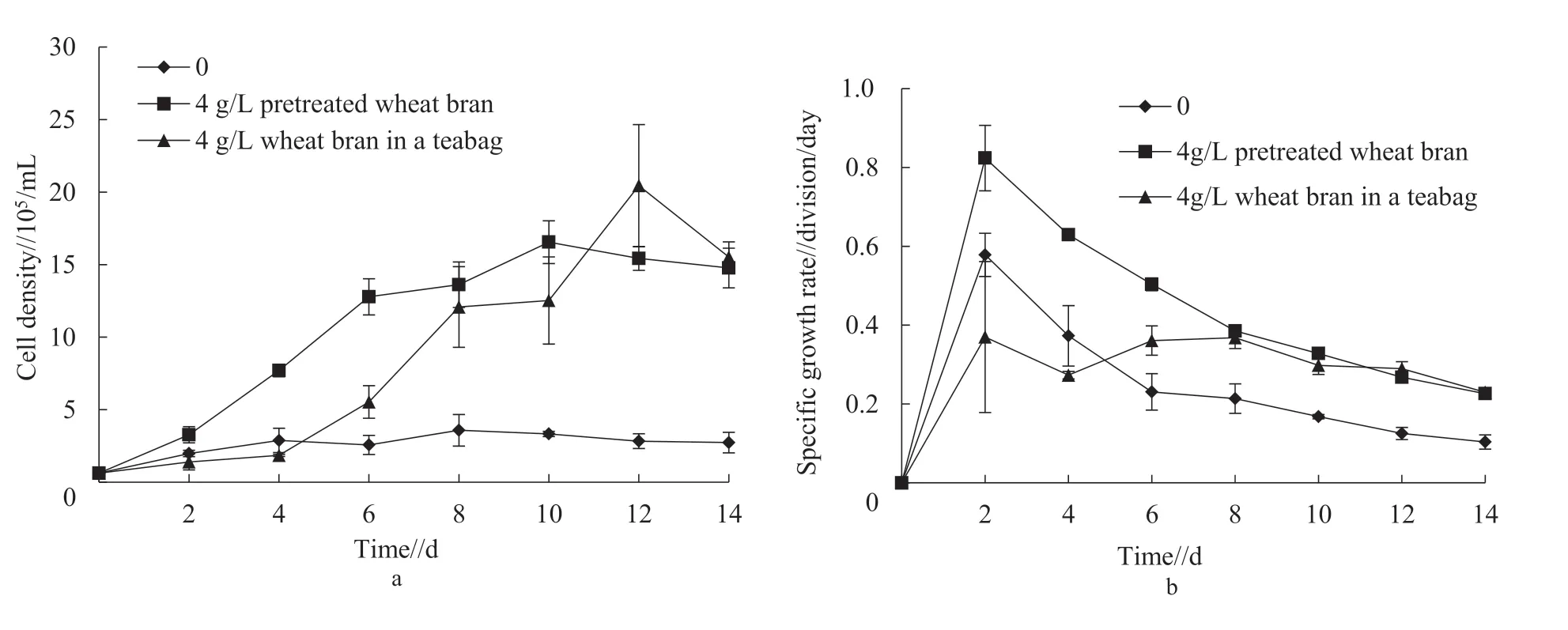
Fig. 5 Growth of P. helgolandica var. tsingtaoensis using pre-treated wheat bran or wheat bran packed in a teabag at 4 g/L(a: the growth curve; b: the specific growth rate)
The results showed that aerobic pretreated wheat bran was more effective in promoting the growth ofP. helgolandicavar. tsingtaoensis in the early stage of the experiment. This indicated that the nutrients from the aerobic pretreated wheat bran were more suitable for the growth ofP. helgolandicavar. tsingtaoensis than the wheat bran without pretreatment. Aerobic or anaerobic fermentation of agricultural residues is a common practice carried out all over the world to make them easier for animals and plants to absorb or to produce other high value-added products[38-42]. Some researches were related with algae cultivation, for example, EL-SHEEKH M Met al.[4]used two fungi to degrade lignocellulose in wheat bran for 7 d and found that the soluble products of treated wheat bran increased the growth, carbohydrate and protein contents of bothChlorella vulgarisandScenedesmus obliquusunder mixotrophic and heterotrophic conditions. HE Y Qet al.[25]found thatBacillus sp. can convert solid organics of wheat bran into soluble nutrients which were essential to algae growth. This study found that the wheat bran degraded aerobically by indigenous microbes can rapidly promote the growth ofP. helgolandicavar. tsingtaoensis. It seemed that it was unnecessary to use specific microorganisms for the degradation of the wheat bran. However, compared with the aerobically pretreated wheat bran, a significant time-lag occurred in the growth ofP. helgolandicavar. tsingtaoensis during the treatment with the wheat bran packed in a teabag. This was because indigenous microbes in wheat bran need air and water to degrade organics. The degradation process started from the beginning of the experiment when the packed wheat bran was added to the algae. The indigenous microbes needed time to degrade the organics; and the degradation process had already been done at the beginning of the experiment when the pretreated wheat bran was added to the algae, therefore, the algae was able to use the nutrients for growth immediately.
In this case, as analyzed above, the oxygen produced by algal photosynthesis kept the aerobic decomposition process going. Thus, the nutrients in the wheat bran were continuously released to support the algae growth. The results showed that it may be necessary to have both algae and bacterium in the culture system forP. helgolandicavar. tsingtaoensis to grow by using wheat bran. In addition, whether or not the wheat bran was pretreated, the final cell densities of the two treatments were similar, because the concentration of wheat bran was the same in both treatments, therefore the amount and composition of the degradation products may be similar. Given the lag period, it was better to cultivateP. helgolandicavar. tsingtaoensis with the wheat bran treated aerobically in advance. This study provided a new approach to cultivateP. helgolandicavar. tsingtaoensis from wheat bran.
4. Conclusion
It was feasible to use wheat bran as the sole nutrient source for the growth ofP. helgolandicavar. tsingtaoensis. The optimum concentration of loose wheat bran for algal growth was 1 g/L. This concentration of wheat bran produced algal growth similar to that of the f/2 medium. A higher concentration (2~4 g/L) of loose wheat bran caused the algae to grow slowly or even to be inhibited for a while at the beginning of the experiment. However, in the later stage of the experiment, the higher the concentration of loose wheat bran, the better the algal growth, except for 8 g/L wheat bran, which totally inhibited the algae growth during the whole experiment. Packed wheat bran promoted algal growth better than loose wheat bran at the same concentration. In addition, compared to 4 g/L packed wheat bran, there was no obvious time-lag in the algal growth at the same concentration of aerobic degraded wheat bran. In conclusion, it was simple and inexpensive to cultivateP. helgolandicavar. tsingtaoensis using wheat bran. Moreover, packaged wheat bran and aerobic fermented wheat bran were preferred for cultivating algae.
 Agricultural Science & Technology2020年3期
Agricultural Science & Technology2020年3期
- Agricultural Science & Technology的其它文章
- A Study on Combining Ability and Heritability of Agronomic Trait of Indica Hybrid Rice
- Breeding of High Quality Indica CMS Line Xinlong A
- Effects of Biological Bacterial Fertilizer on Carbon Metabolism Characteristics of Rhizosphere Soil Bacteria in Rice
- Evaluation of Ecological Environment Competitiveness of Hunan Province Based on Prefecture Level Cities
- Effects of Different Phosphorus Application Rate on the Growth and Development, Yield and Quality of Tobacco in Yongzhou Area
- Influence of Shape and Size of Threshing Frame and Tobacco Grade on Leaf Strip Structure
